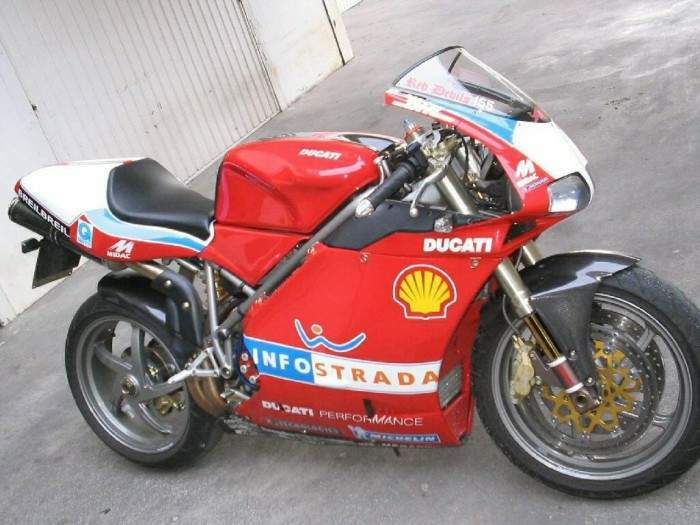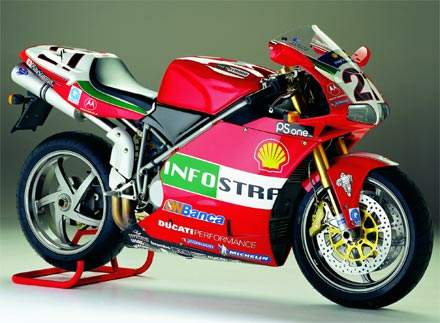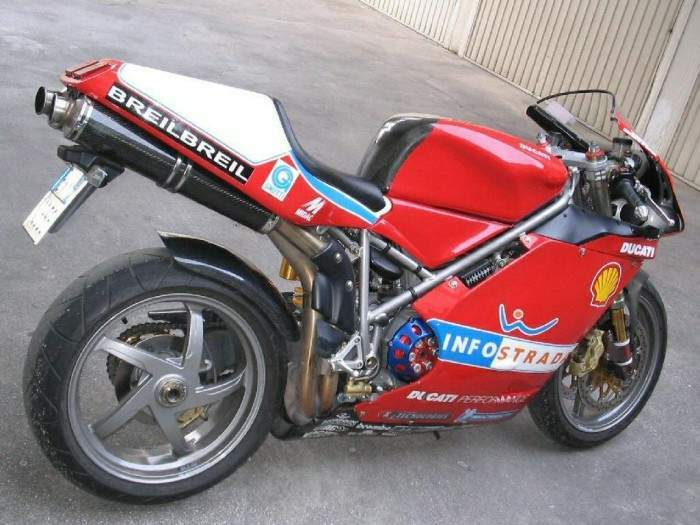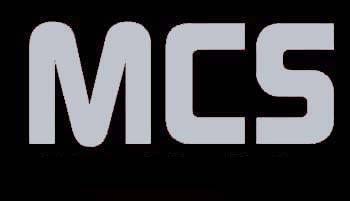Derived from racing bikes that have been consistently winning
WSB championships since WSB began, the first Ducati Superbike, the 851, was
launched in 1987, this bike was followed with the 888, 916, 748 and the 996. The 916 won several worldwide
awards including 4 “Motorcycle of the Year” awards from MCN magazine.
The 996 replaced the 916 in 1998. An entry into
the legend of Italian motorcycling racing, an aggressive, high performance
and beautifully designed machines, closely derived from Ducati’s currently
competing in the WSB. Aimed at purists who want
everything from a bike with its compact design and slim silhouette to
provide superior handling at speeds up to 170 mph.
Combines advanced thermodynamics of 4-valve per cylinder with unsurpassed
efficiency of Desmodromic valve system. For 2002 the 996 is now a 998 and
features the all new "Testastretta" 998 engine with 11 more horsepower then
the 996.

Review
More of the same - much more!
Unbelievably the 916 has been around since 1994. When released the 916
didn't rEVOlutionise the sports bike sector, Honda had already done that
with their Fireblade, but it did put that new definition into perhaps the
prettiest package of the decade. The 916 is still with us and it looks much
the same as it did back in '94. Most people generally agree that, almost ten
years later, it looks up to date. The Ducati has enjoyed gradual updates
year by year, and is still arguably at the top of its class. That's the
history lesson, so what's it like to ride?
In a word, brilliant!
Yes, that's it - BRILLIANT!
At this point I could save this word file and end my report - anything I say
from now on is simply a variation of 'brilliant'. But, ok, you probably
haven't ridden the bike so I'll be sensible and run through this test from
beginning to end, starting with the engine.
This year the entire 916, sorry, it's now the 998 range, benefits from the
new Testastretta, or narrow head, engine. This is the motor Troy Bayliss
used to win the World Superbike title this year.
It comes in three states of tune, 123 bhp for the 998 ridden here, 136 for
the 998S and a claimed 139 bhp for the limited edition customer racer, the
998R. The engine actually displaces 998ccs- hence the name!

On the track it's immediately apparent that in its latest guise the engine
is much more responsive low down than in previous incarnations. The standard
998 is still a little short of puff on top, a GSX-R1000 would laugh at it's
flat-out straight-line performance, but I'd guess that the stronger 139bhp
998R might silence the Suzuki's chuckles. Torrents of torque make the bike
very easy to ride, even if you ham up the gears and exit a corner too far up
the six speed box, the bike will rescue you by pulling strongly from as low
as 2,000 rpm. It'll pull from way below that, but the power pulses from the
two 500cc pistons swinging up and down the 90 degree V create too much
snatch at the drive-train for anyone with mechanical sensitivities to try it
for long. The build up is linear, there's no sudden power band to catch you
out, but there is enough low down grunt to break the rear tyre's traction in
the damp or cold conditions that were prevalent during my track test in
Silverstone. Early in the morning, when damp patches still littered many of
the corners, I lit up the rear tyre causing it to sliding full sideways as I
exited a tight turn. It was a progressive slide and the bike kept itself in
order as I rolled off the throttle gently. The rear hooked up again without
drama when I got back on the power. There wasn't even a hint of high side.
The relative lack of top end, and the fact that I had recently ridden a
four-cylinder race bike with a cut out set at something above 15,000rpm,
meant I was hitting the rather severe rev limiter all too much. It cuts the
engine so efficiently that the faster riders on the track started to use it
as an impromptu quick-shifter!
The gearbox is smooth and precise and the clutch light and accurate - the
bite point stayed in exactly the same place for the entire session. The
engine seems much refined over early models, it's far quieter than the
original 916, the engine, gearbox, clutch and exhaust - they all produce
less clatter and bellow this year. A refined Ducati? Hmmm.
A powerful engine is all very well, but it needs a capable chassis to help
get the power promised by that glorious V-Twin onto the ground and to keep
it there. This is an area that the 916 series has always excelled in and
this year is no different. While the standard 998 isn't as exotically
equipped as its 998R stablemate, it's nonetheless plenty well equipped to
cope with the 123 bhp on tap.

The Brembo brakes are also a notch down from the trick race parts fitted to
the R, but again, the bike stops without drama and without a great deal of
finger effort either! Entering the turns at the end of both the fast front
and back straights at Silverstone gave them a good test, which they passed
with flying colours by providing consistent and dependable braking time and
time again. There was no fade, no excess lever travel, no hint of sponginess
- just plenty of progressive two-fingered braking power all day. Compare
that to the disappointing feel of the early 916 brakes, more evidence that
the 916 is EVOlving well.
Suspension duties on the 998 are taken care of by a pair of Showa front
forks, which are TiN treated even on the 998. TiN (Titanium Nitride) is a
super-slick coating that ensures the fork tubes don't 'stick' to the sliders
under heavy use. The rear end is well controlled by an excellent Ohlins
shock with the usual full range of adjustability. The front brake discs are
thinner this year, lowering the weight hanging on the front wheel and thus
making turn-in even quicker. Indeed, the little 998 (for it is a physically
tiny motorcycle) turns in fast and holds a line with amazing tenacity.
Neither the bumps nor Tarmac ridges at Silverstone could shake the bike,
even on full throttle at full lean.
The 998 comes in any color you ever dreamed of - as long as you only dream
in red or yellow.There was quite a difference in the way the various test
bikes felt. The eight bikes available at the test had all been individually
tweaked at a previous track session, so all the settings were different. On
the softer setups there was quite a bit of wobble at the rear when changing
direction hard, something that was completely absent on the bikes with a
firmer set up. Set up is very much an individual thing, but if you are
serious about riding a bike like this hard, you'll be well advised to get it
properly set up to match your riding style and location. I preferred the
harder set up, at least for the track. Out on the road, where (if we are
honest with ourselves) outright performance isn't that crucial, the softer
settings might well be a better compromise between comfort and performance.
Talking of which, while I am sure the 998 will make a stunning road bike,
there's no denying that a machine like this is most at home on a track,
where its capabilities can be exploited to the full in relative safety.
There are not many roads where you can lean the bike over onto its foot pegs
and then power out of the turn with the rear end smoking and sliding. On the
contrary, Silverstone has many places where such behaviour is encouraged
and, thankfully, unlikely to be interrupted by myopic Volvo pilots or
highway patrol cars.
The front end on the Ducati is extraordinary. The level of grip and control
from the front end is faultless, the front Pirelli gripped at the tarmac
with amazing force. Even a ham-fisted handful of brakes mid-turn when I
realised I had gotten way off line failed to push the front. The bike does
stand a little when braked mid-turn, but a little extra pressure on the
relevant stubby clip-on handlebar corrected this immediately. In the final
turn before the front straight, a long constant radius corner that really
loads the front as you wind the throttle back to get drive for the main
straight, you could actually feel the grip - as if the tyre was in fact your
hands. Superb. The OEM Pirelli Dragon's really compliment the Ducati set up.
Despite a hard day's riding at Silverstone, I failed to reveal any
significant faults on the 998. OK, the more capable riders could get the
rear to break grip and get very sideways mid-turn, although none of them
fell off as a result, confirming that this is a bike that's controllable
even at, or beyond, the limits. What it also revealed was that the new 998
is a real riders' bike, a motorcycle meant to be used hard and used purely
for fun.
For those who dare to be different (and have spare change lying around) you
can pick up one of two replicas built by Ducati for 2002. The Ben
Bostrom Replica 998 S, priced to sell at $22,695. There is also a Troy
Bayliss replica of his Infostrada sponsored machine for around the same
price.This isn't a get-to-work ride, although no doubt some owners will
commute on theirs, possibly because they just have to ride it again and
again! But the 998 is also far from being a banzai, balls-out motorcycle -
it's actually very refined. This all-round user friendly feel is relatively
new on a Ducati, leading one of the testers to comment on how it was getting
like a Honda VFR800, a comment that didn't actually go down too well with
the Ducati factory guys present! It's true though, this is the smoothest and
most civilised version of the 916 ever released. But don't worry, they
haven't washed the soul out of the machine, no way, this is still every bit
a Ducati eight valve Desmo twin. It can still make the hairs stand up on the
back of your neck in time honoured Ducati style.
There's not a lot to run through as far as equipment is concerned, this is a
road bike made from a race bike, so 'accessories' are restricted to stuff
like a steering damper and a dual seat. But, if it ain't needed, it ain't
fitted. There's the usual array of add-on parts, both from Ducati and from a
host of companies that have grown up to serve the increasingly popular
machines. They vary from performance to pretty parts, and a trip to any
Italian motorcycle show will find plenty of illustrations of just how far
you can take 'personalising' a Ducati.
Who would buy the 998? The seriously rich are probably going to want the
more expensive (and more importantly to them, exclusive) 998R or S versions.
Owning an R isn't an easy feat, apart from the cost there won't be many
about and most of them will end up in the hands of privateer racers. Those
on a tight budget are likely to decide that the 998 is too dear, and settle
for an, arguably, equally capable Japanese four. The 998S isn't that much
further up the price scale than the standard 998, and it produces a useful
amount of extra ponies from its higher tuned motor.
Then there's the cheaper Aprilia V-Twins or even a Triumph triple to further
muddy the water of decision. But the answer is simple, the 998 is going to
be purchased by riders who want to experience the credibility, the
exceptional thrill and the soulful experience of Ducati ownership - probably
by those who have already owned a 916. Those who can't or won't stretch the
extra few thousand for the S model will get all of vital Ducati ingredients
with the 998. And whoever buys the 998, if my impressions are anything to go
by then one thing is for certain, they won't be disappointed.
Source
Motorcycle USA
